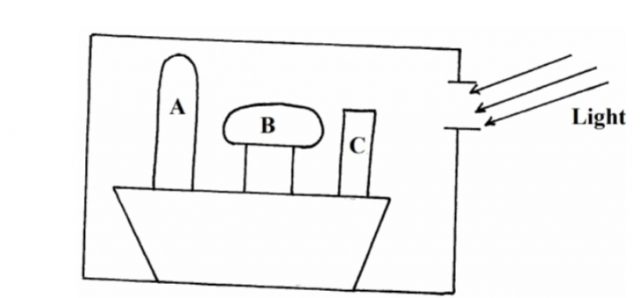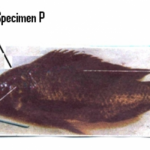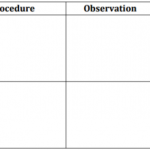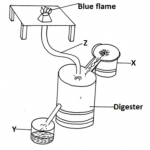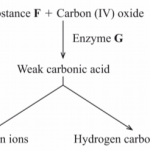KCSE Biology Paper 1 – 2014 EKSIKA Joint Evaluation Test
2014 EKSIKA Joint Evaluation Test
Biology Paper 1
Name the element obtained from insects by insectivorous plants.
1 marks
An experiment was set up using seedlings as shown in the diagram below.
(a) What was the aim of the experiment? (1mk)
(b) Why were seedlings B and C included in the experiment? (1mk)
2 marks
State the importance of the following processes that take place in human nephron.
(a) Ultrafiltration (1mk)
(b) Selective reabsorption (1mk)
2 marks
State the functions of centrioles in a cell.
2 marks
State ONE process that takes place during the light stage and ONE that takes place in the dark stage of photosynthesis.
Light stage;
Dark stage;
2 marks
Give a reason why a diet consisting of maize meal and cabbage if eaten over a long period may lead to Kwashiorkor in children.
2 marks
(a) What is meant by non-disjunction? (1mk)
(b) Give ONE example of continuous variations in humans. (1mk)
2 marks
State the functions of the following parts of mammalian ear.
(a) Ear Ossicles. (1mk)
(b) Semi-circular canals. (1mk)
(c) Eustachian tube. (1mk)
3 marks
Give a reason why primary productivity in an aquatic Ecosystem decreases with depth.
1 marks
State TWO functions of the substance secreted by sebaceous glands.
2 marks
(a) What is homeostasis? (1mk)
(b) Name 3 processes in the human body in which homeostasis is involved.(3mks)
4 marks
Name the regions in plants where the following take place.
(i) Primary growth
(ii) Secondary growth.
2 marks
State THREE reasons for classifying organisms.
3 marks
A student observing a drop of water under the high power objective lens of a microscope observed an organism and drew the following organism.
(a) Suggest the kingdom to which the organism belongs. (1mk)
(b) Identify the organism. (1mk)
(c) Give an example of a disease caused by the organism. (1mk)
3 marks
In an experiment, the pituitary gland of a rat was removed.
(a) State the effect this will have on the quantity of urine produced by the rat. (1mk)
(b) Give a reason for your answer in (a) above. (1mk)
2 marks
State the functions of the following parts of a light microscope.
(a) Objective lens
(b) Diaphragm
2 marks
State THREE structural differences between arteries and veins in mammals.
| Arteries | Veins |
| _ | _ |
| _ | _ |
| _ | _ |
3 marks
State TWO ways in which plants compensate for their inability to move from one place to another.
2 marks
Distinguish between parthenogenesis and parthenocarpy.
2 marks
In view of modern evolution , explain why Lamarkian theory is unacceptable.
2 marks
What is the functional difference between a tendon and a ligament?
1 marks
Name TWO components of blood that are not present in the glumerular filtrate.
2 marks
(a) A person was not able to see far objects clearly but could view near objectsclearly. Name the eye defect the person was suffering from. (1mk)
(b) How can the defect be corrected? (1mks)
2 marks
(a) Name TWO sites where gaseous exchange takes place in terrestrial plants.(2mks)
(b) State the importance of the following features in gaseous exchange.
(i) Cartilage in the trachea. (1mk)
(ii) Moisture on the surface of the alveoli. (1mk)
4 marks
Explain how the following adaptations minimize the rate of transpiration.
(a) Sunken stomata (1mk)
(b) Leaf drooping (1mk)
2 marks
State the role of decomposers in an ecosystem.
1 marks
State THREE advantages of asexual reproduction in organisms.
3 marks
Define the following terms as used in Ecology.
(i) Biosphere.
(ii) Population.
(iii) Standing crop.
(iv) Carrying capacity.
4 marks
(a) Distinguish between Homologous and Analogous structures. (2mks)
(b) Give an example in each cases the structures in (a) above. (2mks)
- Homologous structure.
- Analogous structure.
4 marks
Explain why digestion of starch stops shortly after food enters the stomach.
1 marks
Explain why one fails to see clearly on moving from a brightly lit room to a poorly lit room.
2 marks
What is the significance of meiosis.
2 marks
Explain how the Erythrocytes are adapted to perform their functions.
3 marks
State ONE function of each of the following parts of the brain.
(i) Hypothalamus.
(ii) Cerebrum.
2 marks
